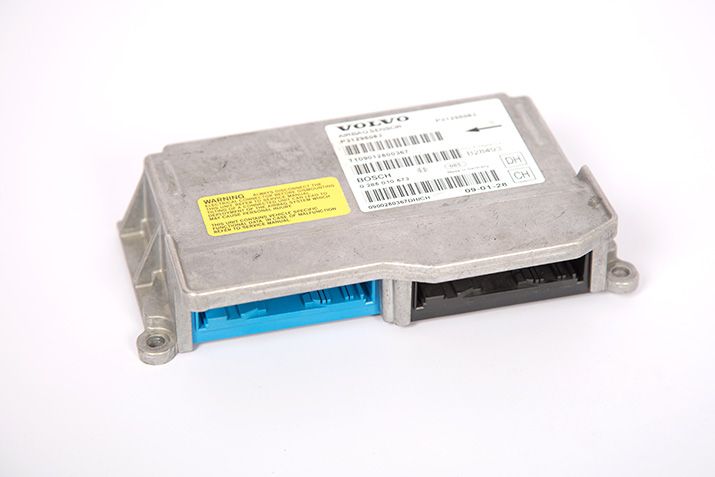The airbag module – the heart of the airbag system
The airbag module is one of the most important parts of a car when it comes to the safety of the driver in occupants in traffic. This is the reason why it is essential for the airbag module to function properly. But where exactly is this airbag module located in the car? How does it function? What to do if the airbag light comes on? These questions and many more about the airbag module are answered by the experts at Airbagbank.

Where is the airbag module located in the car?
Before we explain the individual functions of the airbag module, let’s discuss the frequently asked question: where is the airbag module located in the car? The airbag module is the heart of the airbag system and is installed centrally in the vehicle to ensure proper protection. In most cars, the airbag module is located in the center console under the handbrake. However, the location may vary from vehicle to vehicle. In the illustration below, the individual components of the airbag system are marked where they are located in the vehicle, including the airbag module numbered 2.
Components of the airbag module
Since the airbag module is responsible for detecting accidents and monitors the operational readiness of the entire airbag system, it is the most important component in the airbag system. Any errors are displayed to the driver using the indicator light. The airbag module is divided into the following segments: diagnostic unit and fault memory (monitoring electronics), evaluation electronics with voltage transformer (ignition energy generator), energy storage (ignition capacitor) and accelerometer with safety roll-over sensor (depending on type).
What functions does the airbag module take on?
The airbag module performs the following essential functions that contribute to the safety of all passengers in the car:
- Detect signals delivered by sensors (crash detection)
- Determine the ignition timing for airbags Supply power circuits with energy via ignition capacitor (independent of the vehicle battery)
- Self-diagnosis and control of the entire airbag system
- Error display and storage of previously occurred errors in the error memory
- Activation of the indicator light if the system fails
- Connecting to other modules in the vehicle Seat assignment and passenger seat weight recognition
The airbag module processes all important signals sent by the sensors and uses this information to determine the activation strategy of the airbags. For the activation strategy, the time of impact, impact speed, impact angle, required restraint and the most favorable airbag ignition time are calculated.
Sensors in the airbag system
The airbag system contains sensors, which transmit all information to the airbag module, which is ultimately responsible for the deployment of the airbags. Here, different sensors take on different tasks. There are two different types of sensors that make up the airbag system: crash sensors and safety sensors.
Crash sensors
The crash sensors, also called acceleration sensors, are located in the airbag control unit. In some airbag systems, the sensors may also be located on the front or side of the vehicle. The crash sensors provide information to the airbag module that is needed to detect vehicle deceleration and initiate ignition.
Safety sensors
The velocity sensor prevents unintended activation of the airbags, for example, in the event of a failure of the front sensors. The velocity sensor is integrated in the airbag module and is connected in series with the front sensors.
Fault diagnosis: Common causes of faults in airbag control units
Work on the airbag system should always be carried out by skilled personnel only and all legal and manufacturer-specific regulations should be observed. All faults on and in the airbag system are detected in the airbag control unit and communicated to the driver by the airbag indicator lamp lighting up. Now the search for the cause begins. If you need help with the fault analysis, you can simply fill in the Airbagbank fault form or contact the airbag experts directly by phone or e-mail.
Step 1: Visual inspection
First of all, it is advisable to perform a visual inspection of all visible components of the airbag system to check for damage and proper connections. On 3-door cars, a common cause of failure is, for example, a bad plug connection or defective airbag connectors caused by the constant back and forth movement of the seats. Another source of failure is the coil spring, as this is stressed with every steering movement. In Mercedes or BMW cars, problems often arise with the passenger’s chair mat due to excessive stress. In such cases, a suitable diagnostic system is necessary, with the help of which the error memory of the airbag control unit can be cleared.
Step 2: Read out the airbag control unit
If no defects can be detected during the visual inspection, a diagnostic system must be used to read out the airbag control unit and determine the corresponding fault code. Thanks to self-diagnosis, faults are detected in the airbag control unit itself and stored in the fault memory.
Step 3: Cause elimination
The next step is to resolve these errors and find the cause. For example, water may get into the airbag control unit, causing a short circuit. Other possibilities are defective cables or sensors that trigger the airbag indicator light.
Airbag control unit repair
Purchasing a new airbag control unit can be a very expensive affair. Therefore, an airbag control unit repair is certainly a more cost-effective alternative. In some situations, just resetting the airbag control unit is enough (airbag control unit reset). While an airbag control unit repair by the experts at Airbagbank costs on average only €125, you could quickly spend several hundred Euros on a new control unit. Do you have questions about a repair or reset of your airbag control unit? Then simply contact our airbag specialists or directly fill out the fault form on the website.
Advantages of modern airbag control units
In modern airbag control units, information obtained during executed impact tests is stored. With this information, the control unit can evaluate accidents according to the respective crash severity and select the necessary deployment strategy accordingly.
Crash severity runs from 0 to 3:
- Crash severity 0 is a light impact in which deployment of the airbags is not necessary.
- Crash severity 1 is a moderately severe impact in which deployment of the first-stage seat belt pretensioners is possible.
- Crash severity 2 indicates a severe accident with deployment of the airbags in the first stage. A very severe accident is indicated by crash severity 3. In this case, airbags are deployed in the first and second stages.
Another important function in modern airbag control units is the evaluation of the direction of the accident. This involves measuring the impact of the force on the car in degrees and using this information to determine the deployment strategy. The type of accident and whether or not the occupants are wearing seat belts are also taken into account when deciding the deployment strategy.


